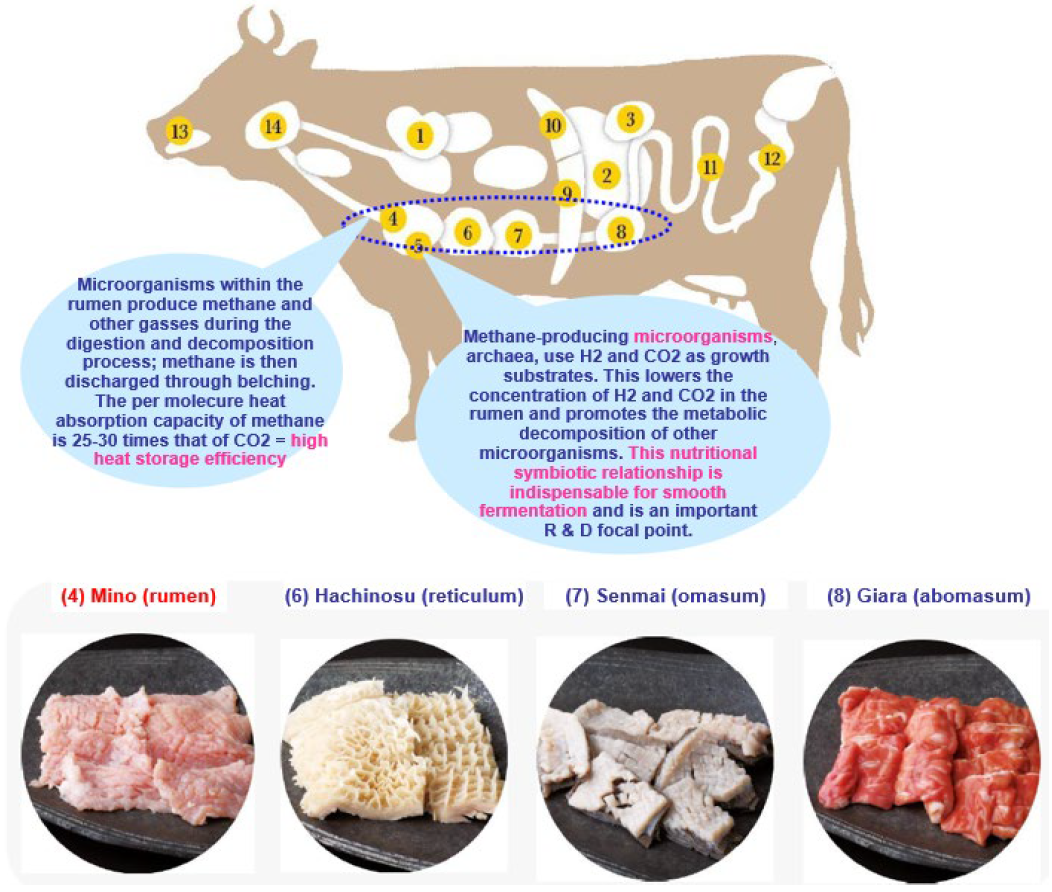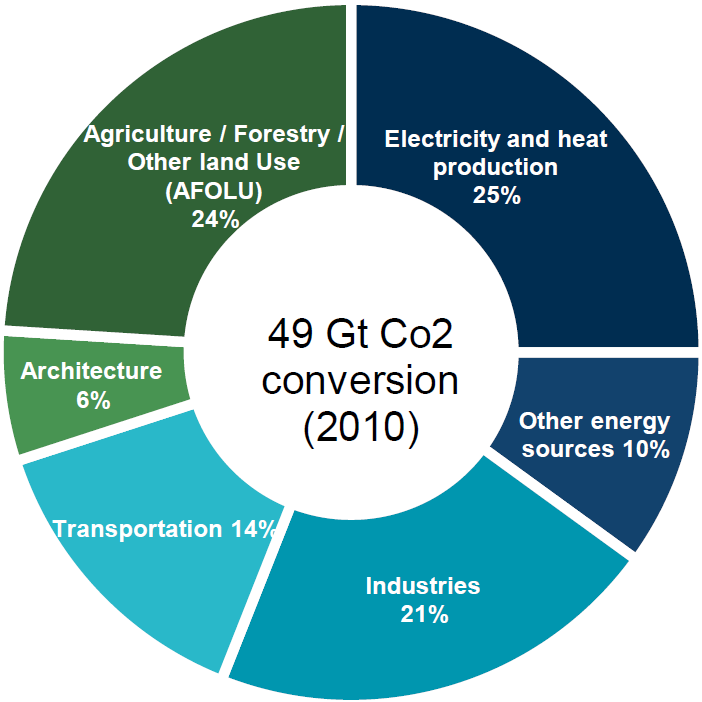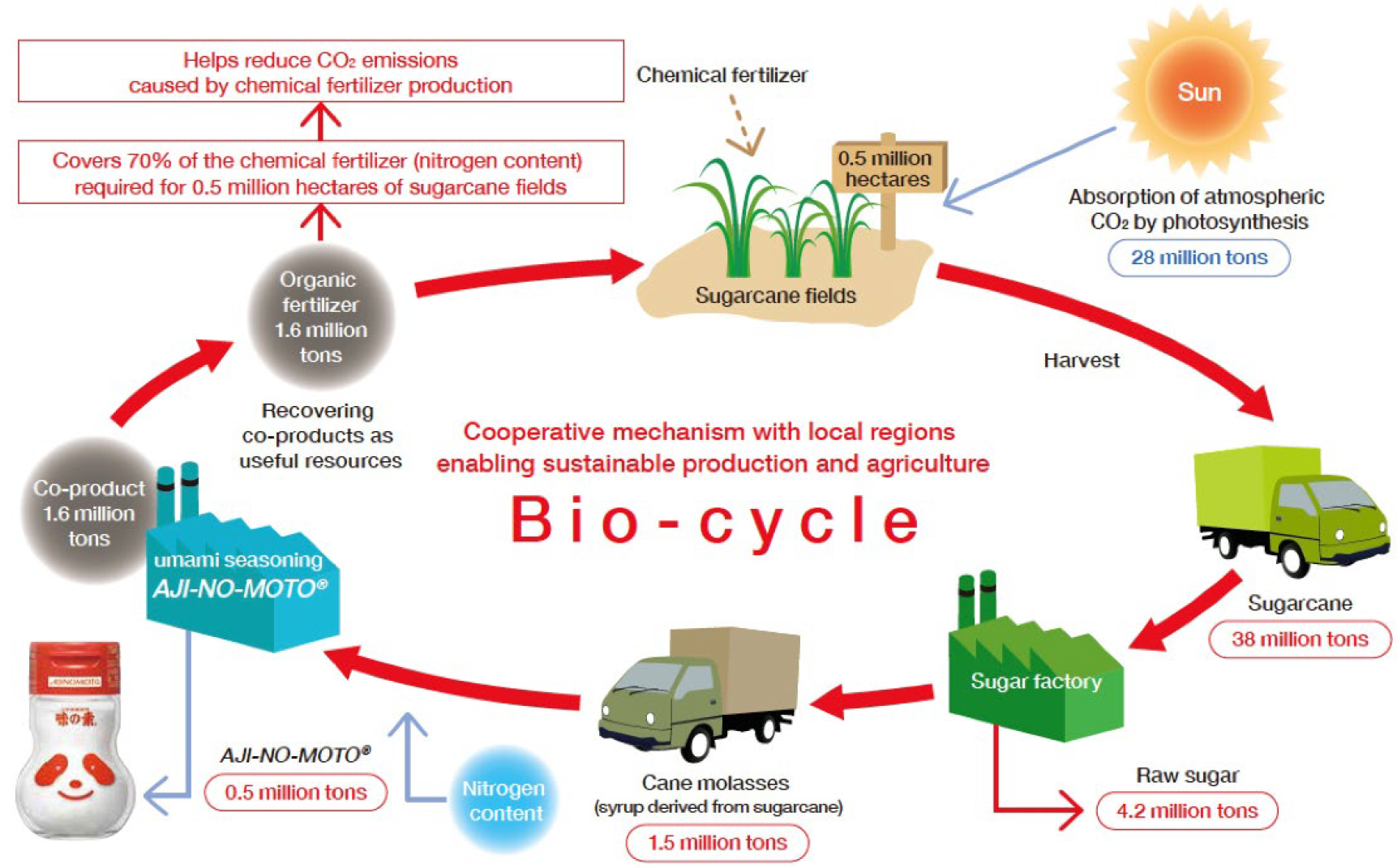Introduction: Good health and well-being
One of the aims of the Nikko AM Japan Value Equity team is to seek companies that have business continuity, offer downside protection, and are likely to possess a turnaround catalyst, even if they are undervalued temporarily. Such enterprises also tend to offer goods and services needed by society. In this article we discuss our thoughts on social issues being addressed by sustainable companies and their contribution towards improving the physical and mental well-being of individuals. The article focuses on “good health and well-being”, which is one of the 17 Sustainable Development Goals set up by the United Nations in 2015 and a concept which is expected to take on added significance in a post-COVID-19 world.
Cattle responsible for a significant amount of GHG emissions
Understanding how cattle emit methane
Cattle are classified as ruminants due to their unique four-compartment stomach. The ruminant stomach of cattle consists of rumen, reticulum, omasum and abomasum.
 Source: Mizuho Securities Equity Research
Source: Mizuho Securities Equity Research
It is the ruminant stomach that makes cattle one of the major emitters of greenhouse gas (GHG). Cattle digest what they eat by breaking the feed down into soluble parts through repeated regurgitation and re-chewing in the ruminant stomach. In a process known as enteric fermentation, microbes in the digestive systems of the livestock generate a significant amount of methane as a byproduct of digestion, and the cattle expel the gas by belching.
Reducing methane from cattle critical to slow global warming
The US Department of Agriculture estimated the global population of cattle at one billion in 2021 and their collective belching has a substantial environmental impact. As Chart 1 shows, agriculture is responsible for a significant portion of global GHG emissions, of which cattle are a major contributor.
Chart 1: Global GHG emissions by economic sector

Note: Gt = billion metric tons
Source: Mizuho Securities Equity Research, based on IPCC AR5 Working Group 3 ReportMethane’s lifetime in the atmosphere is shorter than that of CO2, but methane is said to be 25-30 times more efficient than CO2 in trapping heat within the atmosphere. As such, reducing methane emissions from cattle is critical to slow global warming and presents an immediate opportunity to tackle climate change.
In addition to cutting meat and dairy production, other options for reducing methane emissions include inhibiting methane emitted by cattle. Recent studies have focused on adding agents to cattle feed in an attempt to reduce the amount of methane produced during enteric fermentation. The aim is to target microorganisms called archaea which are found in the ruminant stomach of livestock. These microorganisms use hydrogen, another by-product of the fermentation process caused by bacteria within a ruminant stomach, to produce methane. Recent experiments have focused on using feed additives such as seaweed to limit the amount of hydrogen available to archaea or curbing the number of archaea themselves. Studies related to enteric fermentation, including gaining a deeper understanding of microorganisms like archaea, are expected to become a key area of R&D worth focusing on from an ESG perspective.
Improving physical well-being: A richer eating experience, better nutrition with plant-based foods
Providing plant-based proteins to consumers
Reducing the overall number of livestock may appear to offer a straightforward solution to the methane problem. However, simply reducing cattle populations would also cause a shortage in the supply of protein, one of the three essential food groups along with carbohydrates and dietary fats. Increasing awareness towards sustainability and the environment is one reason why focus has turned to plant-based proteins, which offer both an alternative to meat and a way to reduce methane emissions.
The Ajinomoto Group has played a significant role in providing plant-based protein to consumers around the world. The company’s food seasonings introduced to consumers “umami”, which can be translated as “savoury” and described as the fifth taste along with sour, sweet, bitter and salty. Seasonings with umami add a meaty richness to plant-based protein dishes and have helped improve the eating experience and nutritional balance of many consumers for whom meat is a luxury. Due to such contributions to society, the company, in our view, represents the “S” (social) aspect of ESG principles.
The company was founded in 1909 and has traditionally focused on developing its business in agriculture-producing countries. Being at the source of raw materials is an obvious advantage, but the company’s global stance also reflects its key philosophy, established at the time of its founding, of contributing to society by providing the underprivileged with not only nourishment but an enjoyable eating experience. The food producer, which jostles globally with rivals such as Nestle and Unilever, is a leading player in developing regions such as Africa, where it has become an extensive local presence and has won over the trust of the markets.
A sustainable production system
The company produces amino acids in 18 factories spread out across nine countries. It has used locally available produce such as sugar cane, sugar beet, cassava and corn to produce amino acids through fermentation. The fermentation process produces a nutrition-rich by-product, labelled “co-product” by the company. It utilises nearly 100% of co-products as either fertiliser or feed for livestock. For over 40 years it has used this sustainable, locally established “bio-cycle” system globally for amino acid production. Co-products already are fertilisers rich in nutrition, but it is conducting research to make the substance even more effective as organic fertilisers. Such attempts reflect the company’s drive to improve the productivity and quality of agricultural output and thereby add value. The bio-cycle system (Chart 2) represents a virtuous cycle involving local agricultural producers, processors of the agricultural produce and the company itself.
Chart 2: The sustainable bio-cycle
 Source: The Ajinomoto Group
Source: The Ajinomoto Group
Use of “umami” not just limited to seasoning
The corporation is also a leading presence in the study of identifying and solving health issues associated with dietary practices. It is widely known that excessive salt consumption leads to a number of health problems such as stroke, heart disease, osteoporosis and cancer, and the practice is estimated to have become a serious health issue in more than 95% of countries around the world. Studies have shown that the utilisation of umami seasoning can reduce sodium intake; furthermore, there are hopes that amino acids found in umami could help prevent some of the negative effects of aging and thereby aid the elderly in aging societies maintain or improve their health. As a leading producer of umami, it is positioned to address such societal issues in addition to its traditional role, through which it has helped make high quality protein available to consumers.
The knowledge and skill gained through the production of amino acids can be put to other use as well, notably ammonia production. Ammonia is considered an important source of next generation energy as the world looks to move away from fossil fuels to reduce CO2 emissions. The corporation, also known as a biotechnology entity, is trying to develop a method to produce ammonia in its amino acid production facilities. This would enable the company to make “green” ammonia as production will be small in scale and for local consumption, meaning it would leave a much smaller carbon footprint compared to current ammonia production methods which are capital intensive and large in scale.
Reference to individual stocks is for illustration purpose only and does not guarantee their continued inclusion in the strategy’s portfolio, nor constitute a recommendation to buy or sell.
Improving mental well-being: Creating new “life values”
Mental well-being amid lifestyle changes
In addition to physical health (body), another important aspect of well-being is mental health (mind), which has come into the spotlight as the coronavirus outbreak disrupted lifestyles and workstyles across societies. Many of the changes ushered in or hastened during the pandemic, such as digitalisation and remote work, are likely here to stay.
As societies adapt to such changes and as improving the mental well-being of individuals becomes a key issue, some enterprises are rising to the challenge by offering new lifestyles for a post-pandemic world. One such company is camping gear maker Snow Peak. Already an established outdoor brand with a core global following, it is trying to evolve from a camping-focused enterprise into a business providing "nature-oriented life values” to a wide variety of individuals through many aspects of life. The company sees social values being challenged by rapid digitalisation and advances in technology and its stated social mission is “reviving humanity that has diminished in modern society”.
 Source: Snow Peak
Source: Snow Peak
Reference to individual stocks is for illustration purpose only and does not guarantee their continued inclusion in the strategy’s portfolio, nor constitute a recommendation to buy or sell.
Promoting “nature-oriented life values”
Snow Peak promotes its “nature-oriented life values” in the following aspects of life.
- “Playing”(camping, recreation): Promoting camping as part of everyday life; camping as a way to introduce and promote local communities, camping as a tool to strengthen connections within the family and the workplace
- “Clothing”: Development of clothing suited, in function and design, for both outdoor and everyday use; promotion and preservation of traditional craftsmanship; connecting consumers with local producers through initiatives such as its “local wear” brand; promotion of sustainable clothing production and textile recycling
- “Eating” (food): ): Enriching the outdoor cooking experience; enjoying “off the grid” cooking at home; focusing on locally available, organic produce and traditional farming methods
- “Living” (housing): Promotion of nature-oriented lifestyle tips in urban settings (e.g. back yard camping); urban planning (designing nature-oriented housing blocs to foster community ties)
- “Working”: Improving the working experience by introducing elements of nature (remote working in the garden utilising camping gear etc.); reinforcing workplace connections (holding orientations and off-site meetings in a camping environment, promotion of “camping offices” that utilise outdoor gear and tents within offices)
Helping individuals recover their humanity through contact with nature, according to Snow Peak, is a step towards achieving a sustainable environment as it helps raise awareness that nature needs to be protected and nurtured. Specifically, the company has built a business model that it claims to have transcended mass production and mass consumption by producing products that are very high-spec and designed to be repaired repeatedly instead of being discarded. The outdoor products therefore all come with a lifetime warranty, with the company aiming to have its gear, in addition to its philosophy regarding sustainability, passed on from one generation to the next. The company is also engaged in sustaining traditions. The aforementioned “local wear” clothing brands are made using traditional Japanese craftsmanship, which in many parts of the country are in danger of disappearing.
Creating high brand value by resonating with users
The employees at Snow Peak lead by example in their promotion of nature-oriented values. Many at the company headquarters in Niigata, Japan, go camping after work and return to the office the next day, and their CEO spends roughly a third of the year camping. The company’s philosophy strongly resonates with users around the world, giving it a very high brand value. Snow Peak’s share price has multiplied since 2019, and the company is a good example of brand resonance leading to a larger market cap.
Conclusion
The companies discussed in this paper are a good example of what the Nikko AM Japan Value Equity team seeks through research: enterprises that offer goods and services needed by society and contribute to the well-being of individuals. The Japan Value Equity team strives to identify such companies before the market recognises their full potential value.




